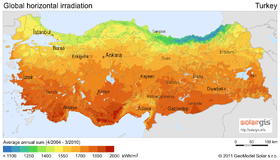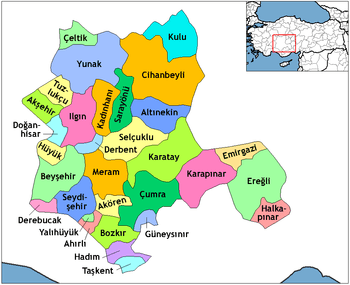Konya
Konya (Turkish pronunciation: [ˈkon.ja]) is a major city in south-central Turkey, on south-western edge of the Central Anatolian Plateau and is the seventh-most-populous city in Turkey with a metropolitan population of over 2.2 million.[1] Konya is a large and industrially developed city[2][3][4] and the capital of Konya Province.
Konya | |
|---|---|
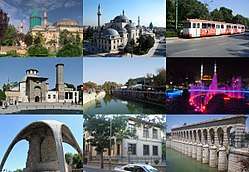 Right from the beginning: Mevlana Museum, Konya Selimiye Mosque, Alaaddin Hill, Ince Minaret Medrese, Meram Nature Park, Hacıveyiszade Mosque, Alaaddin Monument, Atatürk Museum and Taşköprü | |
 Konya Location of Konya, Turkey  Konya Konya (Europe) | |
| Coordinates: 37°52′N 32°29′E | |
| Country | |
| Region | Central Anatolia |
| Province | Konya |
| Government | |
| • Mayor | Ugur Ibrahim Altay (AKP) |
| Area | |
| • Total | 38,873 km2 (15,009 sq mi) |
| Elevation | 1,016 m (3,333 ft) |
| Population (2016)[1] | |
| • Total | 2,161,303 |
| • Density | 56/km2 (150/sq mi) |
| Time zone | UTC+3 (FET) |
| Postal code | 42XXX |
| Area code(s) | (+90) 332 |
| Licence plate | 42 |
| Website | www.konya.bel.tr |
The Konya region has been inhabited since the 3rd millennium BC. Known as Iconium during classical antiquity, the city was ruled successively by the Phrygian, Persian, Hellenistic and Roman civilizations. In the 11th century the Seljuk Turks conquered the area from the Byzantines, and Konya then became the capital of the Sultanate of Rum. Under the Seljuks, the city reached the height of its wealth and influence. Following the demise of Rum, Konya came under the rule of the Karamanids, before being taken over by the Ottoman Empire in the 15th century. After the Turkish War of Independence the city became part of the modern Republic of Turkey.
Name
Konya was known in classical antiquity and during the medieval period as Ἰκόνιον (Ikónion) in Greek (with regular Medieval Greek apheresis Kónio(n)) and as Iconium in Latin. Ikónion is merely the Hellenization of an older Luwian name Ikkuwaniya.[5]
By some the name Ikónion is commonly explained as a derivation from εἰκών (icon), as an ancient Greek legend ascribed its name to the "eikon" (image), or the "gorgon's (Medusa's) head", with which Perseus vanquished the native population before founding the city.[6] In some historic English texts, the city's name appears as Konia or Koniah.
History
Ancient history
.jpg)
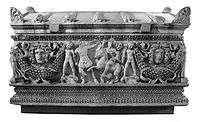
Excavations have shown that the region was inhabited during the Late Copper Age, around 3000 BC.[6] The city came under the influence of the Hittites around 1500 BC. Later it was overtaken by the Sea Peoples in around 1200 BC.
The Phrygians established their kingdom in central Anatolia in the 8th century BC. Xenophon describes Iconium, as the city was called, as the last city of Phrygia. The region was overwhelmed by Cimmerian invaders c. 690 BC. It was later part of the Persian Empire, until Darius III was defeated by Alexander the Great in 333 BC. Alexander's empire broke up shortly after his death and the town came under the rule of Seleucus I Nicator. During the Hellenistic period the town was ruled by the kings of Pergamon. As Attalus III, the last king of Pergamon, was about to die without an heir, he bequeathed his kingdom to the Roman Republic. Once incorporated into the Roman Empire, under the rule of emperor Claudius, the city's name was changed to Claudioconium, and during the rule of emperor Hadrianus to Colonia Aelia Hadriana.
According to the Acts of the Apostles, the apostles Paul and Barnabas preached in Iconium during their first Missionary Journey in about 47–48 AD,[7][8][9] having been persecuted in Antioch, and Paul and Silas probably visited it again during Paul's Second Missionary Journey in about 50.[10][11][12] Their visit to the synagogue of the Jews in Iconium divided the Jewish and non-Jewish communities between those who believed Paul and Barnabas' message and those who did not believe, provoking a disturbance during which attempts were made to stone the apostles. They fled to Lystra and Derbe, cities of Lycaonia. This experience is also mentioned in the Second Letter to Timothy,.[13] 19th century American theologian Albert Barnes suggested that Timothy had been present with Paul in Iconium, Antioch and Lystra.[14] The city became the seat of a bishop, which in ca. 370 was raised to the status of a metropolitan see for Lycaonia, with Saint Amphilochius as the first metropolitan bishop.[15]
In Christian legend, based on the apocryphal Acts of Paul and Thecla, Iconium was also the birthplace of Saint Thecla, who saved the city from attack by the Isaurians.[15]
Under the Byzantine Empire, the city was part of the Anatolic Theme. During the 8th to 10th centuries, the town and the nearby (Caballa) Kaballah Fortress (Turkish: Gevale Kalesi) (location) were a frequent target of Arab attacks as part of the Arab–Byzantine wars.[15]
Seljuk era

The Seljuk Turks first raided the area in 1069, but a period of chaos overwhelmed Anatolia after the Seljuk victory in the Battle of Manzikert in 1071, and the Norman mercenary leader Roussel de Bailleul rose in revolt at Iconium. The city was finally conquered by the Seljuks in 1084.[15] From 1097 to 1243 it was the capital of the Seljuk Sultanate of Rum.[16] It was briefly occupied by the Crusaders Godfrey of Bouillon (August 1097), and Frederick Barbarossa (May 18, 1190) after the Battle of Iconium (1190). The area was retaken by the Turks.
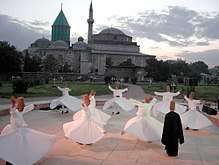
Konya reached the height of its wealth and influence in the second half of the 12th century when the Seljuk sultans of Rum also subdued the Anatolian beyliks to their east, especially that of the Danishmends, thus establishing their rule over virtually all of eastern Anatolia, as well as acquiring several port towns along the Mediterranean (including Alanya) and the Black Sea (including Sinop) and even gaining a momentary foothold in Sudak, Crimea. This golden age lasted until the first decades of the 13th century.
Many Persians and Persianized Turks from Persia and Central Asia migrated to Anatolian cities either to flee the invading Mongols or to benefit from the opportunities for educated Muslims in a newly established kingdom.[17]
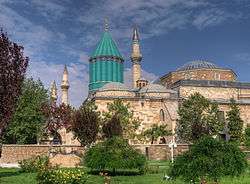
Karamanid era
Following the fall of the Anatolian Seljuk Sultanate in 1307, Konya was made the capital of a Turkish beylik (emirate); which lasted until 1322 when the city was captured by the neighbouring Beylik of Karamanoğlu. In 1420, the Beylik of Karamanoğlu fell to the Ottoman Empire and, in 1453, Konya was made the provincial capital of Karaman Eyalet.
Ottoman era
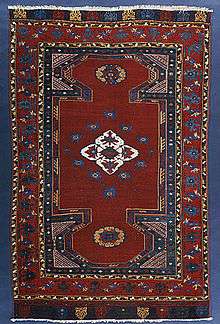
During Ottoman rule, Konya was administered by the Sultan's sons (Şehzade), starting with Şehzade Mustafa and Şehzade Cem (the sons of Sultan Mehmed II), and later the future Sultan Selim II. Between 1483 and 1864, Konya was the administrative capital of Karaman Eyalet. During the Tanzimat period, as part of the vilayet system introduced in 1864, Konya became the seat of the larger Vilayet of Konya which replaced Karaman Eyalet.
Turkish War of Independence
Konya had a major air base during the Turkish War of Independence. In 1922, the Air Force was renamed as the Inspectorate of Air Forces[lower-alpha 1] and was headquartered in Konya.[18][19] The Third Air Wing[lower-alpha 2] of the 1st Air Force Command[lower-alpha 3] is based at the Konya Air Base. The wing controls the four Boeing 737 AEW&C Peace Eagle aircraft of the Turkish Air Force.[20][21]
Population exchange between Greece and Turkey
In 1923 in the frame of the population exchange between Greece and Turkey, the Greeks that inhabited Konya left as refugees and settled in Greece. At the same time, a significant influx of Albanians came and settled in the area.[22]
Government
The first local administration in Konya was founded in 1830. This administration was converted into a municipality in 1876.[lower-alpha 4] In March 1989, the municipality became a Metropolitan Municipality. As of that date, Konya had three central district municipalities (Meram, Selçuklu, Karatay) and a Metropolitan Municipality.
Geography
Konya is the center of the largest province, the largest plain (Konya Plain) and is among the largest cities in the country. It is the seventh most populated city in Turkey.[23]
The city is in the southern part of the Central Anatolia Region. The land is broad and flat with a lot of lowlands and plateaus. The plateaus are covered with rich steppes, therefore, affecting the agriculture sector. Additionally, the southernmost part of Konya is largely surrounded by the Taurus Mountains.
The city and the southern parts of the greater Konya enjoy abundant sunshine across the country, resulting in big potential in solar farming. The largest solar farm of Turkey is located 20 miles west of the city.
Lakes
Lake Tuz, known in Turkish as Tuz Golu, is the second-largest lake in all of Turkey. This lake supplies Turkey with a large amount of Turkey's salt demand.
Beysehir Lake is on the western part of Konya and is near the border. It is known to be the largest fresh water lake in Turkey and one of the most important national parks. Beysehir Lake is important for tourism in Konya and attracts thousands of people each year to its 2 beaches and 22 islands for water and mountain sports.
Meke Lake is on the border of the Karapinar province and is considered to be a heavily protected natural area.
Lake Aksehir is on the border of the Afyon Karahisar province and it is famous from "Nasreddin Hodja" stories. The lake also provides a good habitat for famous "Aksehir cherries".
Climate
Konya has a cold semi-arid climate (BSk) under the Köppen classification[24] and a hot summer continental (Dca) or hot summer oceanic (Doa) climate under the Trewartha classification.
Summers temperatures average 30 °C (86 °F). The highest temperature recorded in Konya was 40.6 °C (105 °F) on 30 July 2000. Winters average −4.2 °C (24 °F). The lowest temperature recorded was −26.5 °C (−16 °F) on 6 February 1972. Due to Konya's high altitude and its dry summers, nightly temperatures in the summer months are cool. Precipitation levels are low, but precipitation can be observed throughout the year.
| Climate data for Konya (1929–2017) | |||||||||||||
|---|---|---|---|---|---|---|---|---|---|---|---|---|---|
| Month | Jan | Feb | Mar | Apr | May | Jun | Jul | Aug | Sep | Oct | Nov | Dec | Year |
| Record high °C (°F) | 17.6 (63.7) |
23.8 (74.8) |
28.9 (84.0) |
34.6 (94.3) |
34.5 (94.1) |
36.7 (98.1) |
40.6 (105.1) |
39.0 (102.2) |
37.2 (99.0) |
31.6 (88.9) |
27.0 (80.6) |
21.8 (71.2) |
40.6 (105.1) |
| Average high °C (°F) | 4.6 (40.3) |
6.8 (44.2) |
11.7 (53.1) |
17.5 (63.5) |
22.2 (72.0) |
26.6 (79.9) |
30.1 (86.2) |
30.1 (86.2) |
25.9 (78.6) |
19.8 (67.6) |
13.0 (55.4) |
6.5 (43.7) |
17.9 (64.2) |
| Daily mean °C (°F) | −0.2 (31.6) |
1.4 (34.5) |
5.5 (41.9) |
11.0 (51.8) |
15.8 (60.4) |
20.1 (68.2) |
23.5 (74.3) |
23.1 (73.6) |
18.5 (65.3) |
12.5 (54.5) |
6.3 (43.3) |
1.7 (35.1) |
11.6 (52.9) |
| Average low °C (°F) | −4.2 (24.4) |
−3.3 (26.1) |
−0.2 (31.6) |
4.3 (39.7) |
8.5 (47.3) |
12.5 (54.5) |
15.7 (60.3) |
15.5 (59.9) |
10.9 (51.6) |
5.7 (42.3) |
0.7 (33.3) |
−2.3 (27.9) |
5.3 (41.5) |
| Record low °C (°F) | −28.2 (−18.8) |
−26.5 (−15.7) |
−16.4 (2.5) |
−8.6 (16.5) |
−1.2 (29.8) |
1.8 (35.2) |
6.0 (42.8) |
5.3 (41.5) |
−3.0 (26.6) |
−11.0 (12.2) |
−20.0 (−4.0) |
−26.0 (−14.8) |
−28.2 (−18.8) |
| Average precipitation mm (inches) | 37.4 (1.47) |
28.7 (1.13) |
28.9 (1.14) |
32.2 (1.27) |
43.5 (1.71) |
24.7 (0.97) |
6.3 (0.25) |
4.9 (0.19) |
12.4 (0.49) |
29.7 (1.17) |
32.1 (1.26) |
41.6 (1.64) |
322.4 (12.69) |
| Average precipitation days | 9.5 | 8.1 | 8.6 | 8.7 | 10.2 | 6.3 | 2.1 | 1.4 | 2.9 | 5.8 | 6.3 | 9.7 | 79.6 |
| Average relative humidity (%) | 79 | 74 | 65 | 57 | 56 | 50 | 41 | 40 | 46 | 58 | 72 | 80 | 60 |
| Mean monthly sunshine hours | 102.3 | 130.0 | 182.9 | 213.0 | 275.9 | 318.0 | 359.6 | 347.2 | 285.0 | 223.2 | 159.0 | 99.2 | 2,695.3 |
| Mean daily sunshine hours | 3.3 | 4.6 | 5.9 | 7.1 | 8.9 | 10.6 | 11.6 | 11.2 | 9.5 | 7.2 | 5.3 | 3.2 | 7.4 |
| Source 1: Turkish State Meteorological Service[25] | |||||||||||||
| Source 2: Deutscher Wetterdienst (humidity 1931–1960)[26] | |||||||||||||
Education
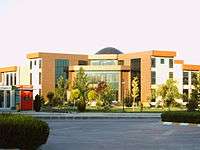
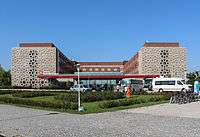
Konya hosts the Tactical Training Center Anatolian Eagle, a center for training NATO Allies and friendly Air Forces. Real Like training environment with large area and skilled aggressors provides a training opportunity to reach the maximum combat readiness for Air Force Fighters. Official Web Site
Selçuk University had the largest number of students, 76,080, of any public university in Turkey during the 2008–09 academic year.[27] It was founded in 1975. The other public university is Necmettin Erbakan University which was established in Konya in 2010.[28]
Private colleges in Konya include the KTO Karatay University.[29]
Economy
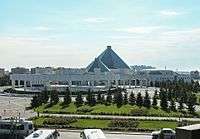
The city ranks among the Anatolian Tigers.[2][3][4] There are a number of industrial parks.[30] In 2012 Konya's exports reached 130 countries.[30] A number of Turkish industrial conglomerates, such as Kombassan Holding, have their headquarters in Konya.[31]
While agriculture-based industries play a role, the city's economy has evolved into a center for the manufacturing of components for the automotive industry; machinery manufacturing; agricultural tools; casting industry; plastic paint and chemical industry; construction materials; paper and packing industry; processed foods; textiles; and leather industry.[30]
Transportation
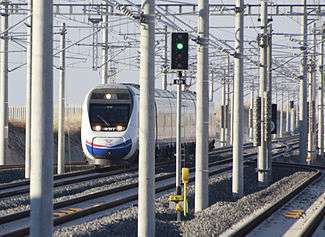

Bus
The bus station has connections to a range of destinations, including Istanbul, Ankara and İzmir.
Tram
Konya has a tramway network in the city center, on which the Škoda 28 T trams are being used.[32] The Konya Metro is currently in the planning and development phase and is slated for construction starting in 2020.
Railway
Konya is connected to Ankara, Eskişehir and Istanbul via the high-speed railway services of the Turkish State Railways.[33][34]
Airport
Konya Airport is a public airport and military airbase that is also used by NATO. In 2006, Konya Airport served 2,924 aircraft and 262,561 passengers.[35]
Notable people
- Amphilochius of Iconium, 4th century Christian bishop.[36]
- Kaloyan (Byzantine Greek: Καλό Γιάννη, "Kalo Yianni," literally 'good John') architect of Cappadocian Greek origin[37] who constructed the Gök Medrese in Sivas.[38]
- Shah Jalal Famous Sufi Muslim figure in Bangladesh
- Jalal al-Din Muhammad Rumi, also called mawlana or Mevlana, was the inspirer of the Sufi Mevlevi order (known for the Whirling Dervishes and Masnavi). He died in Konya in 1273 and his mausoleum is located here.[39]
- Prokopios Lazaridis, Greek Orthodox metropolitan bishop of the Metropolis of Iconium[40][41]
- Orkut Büyükkökten, a software engineer who developed the social networking service Orkut, was born in 1975 in Konya.[42]
- Mehmet Oz, has a degree as a cardiothoraic surgeon from University of Columbia, a popular televised doctor on The Oprah Winfrey Show, and his own medical informative TV serie The Dr. Oz Show.
- Hilmi Şenalp (1957-), architect.[43]
Main sights
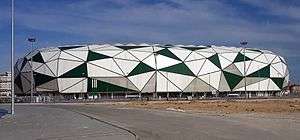
- Sille, 8 kilometres (5.0 miles) northwest from Mevlana Museum: antique village, mosques, churches, cave churches and catacombs
- Ince Minaret Medrese—Museum[44]
- Karatay Medrese—Museum[44]
- Konya Ethnography Museum[44]
- Konya Archaeological Museum[45]
- Atatürk's House Museum[44]
- Mevlâna Museum
Sports
There is one stadium in the city. Its name is Konya Metropolitan Stadium.
Konyaspor is the football club of the city, that appear in Turkish Professional Football League. On May 31, 2017, they won the first national trophy of their history, winning Türkiye Kupası in the final against İstanbul Başakşehir in penalty shootout. The team repeated on August 6, 2017, following winning Türkiye Süper Kupası against Turkey's Beşiktaş champion.
The city is scheduled to host the 2022 Islamic Solidarity Games.
Culture
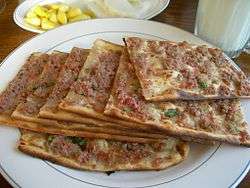
Konya was the final home of Rumi (Mevlana), whose tomb is in the city. In 1273, his followers in Konya established the Mevlevi Sufi order of Islam and became known as the Whirling Dervishes. Konya has the reputation of being one of the more religiously conservative metropolitan centers in Turkey. It was once known as the "citadel of Islam" and its inhabitants are still comparatively more devout than those from other cities.[46]
Every Thursday and Saturday, one can see a performance (Sama) by the Whirling Dervishes at the Mevlana Museum. Unlike commercial performances staged at other cities like Istanbul, this is a spiritual session meant to maintain the sanctity of the Order's tradition.
Konya produced Turkish carpets that were exported to Europe during the Renaissance.[47][48] These expensive, richly patterned textiles were draped over tables, beds, or chests to proclaim the wealth and status of their owners, and were often included in the contemporary oil paintings as symbols of the wealth of the painter's clients.[49]
A Turkish folk songs is named Konyalım, Konyalıya Güzel Derler and Konyalım Yaman Çalar Şak Şak Kaşığı, making reference to a loved one from Konya.[50]
The local cuisine of Konya includes dishes made of bulgur wheat and lamb meat.[51] One of the renowned dishes of the city is etli ekmek, which is similar to lahmacun and pizza.[51]
Food:
Etli ekmek – flat bread baked with ground meat, peppers, onions, and tomatoes
Pişmaniye – similar to American cotton candy and resembling a fully white ball of yarn
Fırın kebab – oven-cooked meat (usually lamb)
Various candies – Konya is known for its sweets, including cezerye, an old Turkish sweet made of carrots
Tirit – a traditional rice dish that is made with meat and various vegetables
Tavuk suyu – a tomato broth-based soup made with shredded chicken and noodles
Twin towns – sister cities
Konya is twinned with:
See also
- Mevlâna Museum
- Anatolian Tigers
- Konya Carpets and Rugs
- Christian saints born in Iconium
- Theodosius the Cenobiarch (c. 423–529 AD), monk, abbot, and saint born in Iconium; a founder and organiser of the cenobitic way of monastic life
- Thecla or Tecla, 1st-century virgin saint of the early Christian Church born in Iconium
Sources
Notes
- Turkic:Kuva-yı Havaiye Müfettişliği
- Ana Jet Üssü or AJÜ
- Hava Kuvvet Komutanlığı
- "İhtisab Agalıgi" (Islamic-Ottoman office for public regularity)
References
- "Turkey: Major cities and provinces". Citypopulation.de. Retrieved 2015-02-08.
- "Financial Times: Reports — Anatolian tigers: Regions prove plentiful". Ft.com. Retrieved 7 August 2018.
- root. "Anatolian Tigers". Investopedia. Retrieved 25 May 2015.
- "Zaman: Anatolian tigers conquering the world". Archived from the original on 2013-08-21. Retrieved 2013-08-21.
- Klein, Jared; Joseph, Brian; Fritz, Matthias (2017). Handbook of Comparative and Historical Indo-European Linguistics. De Gruyter. p. 239. ISBN 978-3-11-026128-8.
- "Konya". Encyclopædia Britannica. Retrieved 25 May 2015.
- Acts 13:51
- Acts 14:1–5
- Acts 14:21)
- Acts 16:2
- Ramsay, William Mitchell (1908). The Cities of St. Paul. A.C. Armstrong. pp. 315–384.
- Bruce, Frederick Fyvie (1977). Paul: Apostle of the Heart Set Free. Eerdmans. p. 475. ISBN 978-0-8028-3501-7.
- 2 Timothy 3:10-13
- "Acts 14 Barnes' Notes". Bible Hub. Retrieved 2019-08-29.
- Foss, Clive (1991). "Ikonion". In Kazhdan, Alexander (ed.). Oxford Dictionary of Byzantium. London and New York: Oxford University Press. p. 985. ISBN 978-0-19-504652-6.
- Hiro, Dilip (2011). Inside Central Asia. Gerald Duckworth & Company. p. 76. ISBN 978-0-7156-4038-8.
- Mango, Andrew (1972). Discovering Turkey. Hastings House. p. 61. ISBN 0-8038-7111-2. OCLC 309327.
- "Bir Hata Oluştu". Hvkk.tsk.tr. Archived from the original on 5 May 2015. Retrieved 25 May 2015.
- Kocatürk, Utkan (1983). Atatürk ve Türkiye Cumhuriyeti tarihi kronolojisi, 1918–1938 (in Turkish). Türk Tarih Kurumu Basımevi. p. 634.
- Mehmet Kayhan YILDIZ- Hasan BÖLÜKBAŞ- Serdar ÖZGÜR- Tolga YANIK- Hasan DÖNMEZ/ KONYA,(DHA). "TSK yeni yıldızı Barış Kartalı'na kavuştu". HÜRRİYET – TÜRKİYE'NİN AÇILIŞ SAYFASI. Retrieved 25 May 2015.
- "Turkey takes delivery of military aircraft". TodaysZaman. Archived from the original on February 22, 2015. Retrieved 25 May 2015.
- "IFMSA Exchange Portal". Exchange.ifmsa.org. Retrieved 7 August 2018.
- "Turkey: Provinces & Major Cities – Statistics & Maps on City Population". Archived from the original on 2017-01-14. Retrieved 2013-12-31.
- "Updated world map of the Köppen-Geiger climate classification" (PDF). Hydrology and Earth System Sciences Discussions. Retrieved 7 August 2018.
- "Resmi İstatistikler: İllerimize Ait Genel İstatistik Verileri" (in Turkish). Turkish State Meteorological Service. Archived from the original on 13 January 2019. Retrieved 13 January 2019.
- "Klimatafel von Konya / Türkei" (PDF). Baseline climate means (1961–1990) from stations all over the world (in German). Deutscher Wetterdienst. Retrieved 13 January 2019.
- "Small Ruminant Congress". kucukbas2014.com. 2014-10-18. Archived from the original on 2014-10-18. Retrieved 2019-08-29.CS1 maint: unfit url (link)
- "Konya Necmettin Erbakan Üniversitesi". Archived from the original on 27 April 2015. Retrieved 25 May 2015.
- "KTO Karatay Üniversitesi". Karatay.edu.tr. Retrieved 2011-09-16.
- "General Overview Of The Konya Economy". En.kto.org.tr. Retrieved 25 May 2015.
- "History « Kombassan Holding". Kombassan.com.tr. Archived from the original on 2015-05-25. Retrieved 25 May 2015.
- "Škoda Transportation wins Konya tram contract". Railway Gazette. 2013-03-04. Retrieved 2019-08-29.
- "Opening of Ankara – Konya fast line completes strategic link". Railway Gazette. 24 August 2011. Retrieved 2013-02-12.
- "Invensys commissions ERTMS solution on Turkish High Speed Line". European Railway Review. 7 September 2011. Archived from the original on 6 January 2012. Retrieved 20 December 2011.
- "Konya Hava Meydanı". DHMİ (State Airports Authority) (in Turkish). Archived from the original on 2010-01-13. Retrieved 2019-08-29.
- Thonemann, Peter (2011-05-04). "Amphilochius of Iconium and Lycaonian Asceticism". Journal of Roman Studies. 101: 185–205. doi:10.1017/s0075435811000037. ISSN 0075-4358.
- Speros Vryonis (1981). Studies on Byzantium, Seljuks, and Ottomans. p. 282.
Perhaps the best known of these architects was the Greek from Konya, Kaloyan, who worked on the Ilgin Han in 1267-8 and three years later built the Gök Medrese of Sivas.
- ŞAHİN, SAMİ (2016-10-18). "Sıvas Blue Madrasa (Sahibia Madrasa) And The Traditional (Hadith) Value Of The Narratives On Its Inscriptions" (PDF). Cumhuriyet University Journal of Faculty of Theology (in Turkish and English). 10 (1): 145–163. OCLC 960847402.
- Battutah, Ibn (2002). The Travels of Ibn Battutah. London: Picador. pp. 106, 309. ISBN 978-0-330-41879-9.
- Savramis, Demosthenes (1968). Die soziale Stellung des Priesters in Griechenland [Social position of the priest in Greece] (in German). E. J. Brill.
- Kiminas, Demetrius (2009). The ecumenical patriarchate : a history of its metropolitanates with annotated hierarch catalogs. San Bernardino, CA: Borgo Press. p. 100. ISBN 978-1-4344-5876-6.
- "Introduction to Orkut". Programmerworld.net. Retrieved 25 May 2015.
- Rizvi, Kishwar (2015). The Transnational Mosque: Architecture and Historical Memory in the Contemporary Middle East. UNC Press Books. p. 56. ISBN 978-1-4696-2117-3. Retrieved 16 May 2020.
- "Konya Museums and Ruins". www.ktb.gov.tr.
- McLean, B. Hudson (2018). Greek and Latin Inscriptions in the Konya Archaeological Museum. British Institute of Archaeology at Ankara. ISBN 978-1-898249-14-6. Retrieved 7 August 2018 – via Google Books.
- "'Islam problem' baffles Turkey". BBC NEWS. 2004-12-03. Retrieved 2019-08-29.
- King, Donald; Gallery, Hayward (1983). The Eastern carpet in the Western world from the 15th to the 17th century. Arts Council of Great Britain. pp. 26–27, 52–57. ISBN 978-0-7287-0362-9.
- Campbell, Gordon (2006). "Carpet II: History". The Grove Encyclopedia of Decorative Arts. 1. Oxford University Press. p. 189. ISBN 978-0-19-518948-3.
- "Carpets of the Ottoman Period". Old Turkish Carpets. 2019-06-19. Retrieved 2019-08-29.
- "Konyalım". bekirhoca.com (in Turkish). Archived from the original on 2007-09-28. Retrieved 2019-08-29.
- "Konya Büyükşehir Belediyesi". Konya.bel.tr (in Turkish). Retrieved 2019-08-29.
- "Rumi Remembered in Birthplace of Shams". Archived from the original on 7 April 2015. Retrieved 21 March 2015.
- "PAKISTAN – TURKEY JOINT STATEMENT" (Press release). Islamabad, Pakistan. Pakistan Ministry of Foreign Affairs. 2008-10-31. Archived from the original (HTML) on 2012-02-11. Retrieved 2018-03-30.
- Kyoto İle Kardeş Şehir Protokolü İmzalandı, Heyet Japon Parkı'nı Gezdi Archived 2014-10-16 at the Wayback Machine, Konya Büyükşehir Belediyesi (2010)
General
- "About Konya/ Geography and Transportation". Konya Sanayi Odasi. Archived from the original on September 3, 2017. Retrieved November 12, 2016.
- Gould, Kevin. "Konya, In a Whirl of its Own". The Guardian. Retrieved November 12, 2016.
- "7 Good Eats in Konya". My Traveling Joys. Retrieved November 12, 2016.
Further reading
Published in the 19th century
- "Konia". Handbook for Travellers in Turkey (3rd ed.). London: J. Murray. 1854. OCLC 2145740.
- Clément Huart (1897). Konia, la ville des derviches tourneurs (in French). Paris: Leroux.
Published in the 20th century
- "Konia", The Encyclopædia Britannica (11th ed.), New York: Encyclopædia Britannica, 1910, OCLC 14782424
- E. Broadrup (1995). "Konya/Catal Huyuk". International Dictionary of Historic Places. Chicago: Fitzroy Dearborn.
Published in the 21st century
- C. Edmund Bosworth, ed. (2007). "Konya". Historic Cities of the Islamic World. Leiden: Koninklijke Brill.
- "Konya". Grove Encyclopedia of Islamic Art & Architecture. Oxford University Press. 2009.
External links
| Wikimedia Commons has media related to Konya. |
| Wikisource has the text of the 1911 Encyclopædia Britannica article Konia. |

- Encyclopædia Britannica: Konya
- More information about Konya
- Emporis: Database of highrises and other structures in Konya
- Detailed Pictures of Mevlana Museum
- Pictures of the city, including Mevlana Museum and several Seljuk buildings
- 600 Pictures of the city and sights
- Extensive collection of pictures of the Mevlana museum in Konya
- Ramsay, William Mitchell (1908). The Cities of St. Paul. A.C. Armstrong. pp. 315–384.
- ArchNet.org. "Konya". Cambridge, Massachusetts, USA: MIT School of Architecture and Planning. Archived from the original on 2012-10-23. Retrieved 2013-02-10.
- "Konya". Islamic Cultural Heritage Database. Istanbul: Organization of Islamic Cooperation, Research Centre for Islamic History, Art and Culture. Archived from the original on May 16, 2013.
